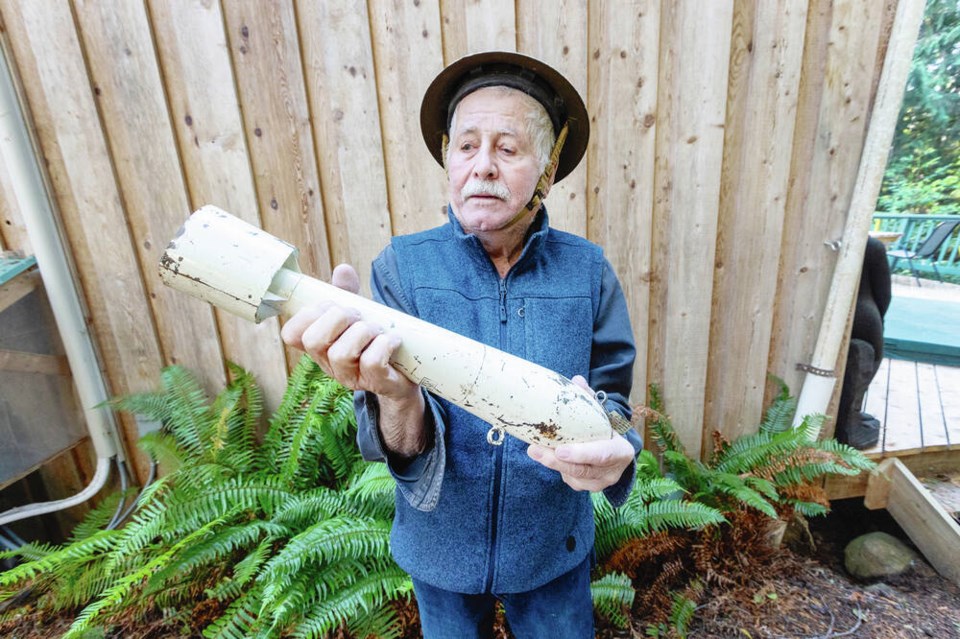Eighty years ago today, the Second World War came home to the Saanich Peninsula.
Literally.
On Nov. 16, 1942, a Mrs. A. Bramwell was doing the dishes when a bomb plowed through her roof and into her drainboard.
Happily, when the Royal Canadian Air Force accidentally attacked her house that day, there were no casualties other than some kitchenware that bravely gave its life in the name of freedom.
The lack of bloodshed is probably why the Cordova Bay Blitzkrieg remains one of the lesser-known campaigns of the war.
It happened when five unarmed practice bombs somehow escaped a twin-engine Hampden bomber on a training flight from the Patricia Bay Airport.
One of the five plunged into the Haliburton Road house of James Muldoon, who lived half a kilometre east of what is now the Pat Bay Highway. Three others buried themselves in a field in the nearby Norris estate.
The fifth crashed into Bramwell’s kitchen, missing her by less than an arm’s length.
According to the Victoria Times, the five-kilogram bomb “came through the roof at an angle, leaving a hole eight inches in diameter, tore a large piece out of the gyproc ceiling, passed over [Bramwell’s] shoulder, hit the drainboard … smashed a cabinet holding kitchen utensils and then went out of the house again at the baseboard, tearing away two or three cedar planks as it left.”
White smoke from the bomb’s acid detonator filled the house, which was three doors south of McMorran’s Pavilion, but Mrs. A. Bramwell (or perhaps Bramhall; the records are a bit wobbly on that point) herself escaped unscathed.
Indeed, when young David Genn arrived on the scene in the company of his father, Kenneth, who investigated the incident as deputy controller of civil defence, Bramwell didn’t seem terribly fussed at all.
“She wasn’t too rattled,” he recalled. “You only get bombed in your dishwater once in your lifetime, so she felt pretty secure after that.”
Genn, just a few years old at the time, still has a practice bomb identical to the one that hit the house.
Peter Goddard, a Royal Oak school classmate of Genn’s, was also around for the incident. Then six years old, he lived next to Muldoon, whose home stood roughly where Del Monte Avenue and Doral Place meet.
Several years ago, Goddard described how Muldoon arrived from next door in an agitated state. “He was all upset because he came in from outside and found this hole in his floor.”
Muldoon was dumbfounded. He couldn’t figure out what had caused this mysterious opening from which white smoke was billowing. It was left to Goddard’s father to point out to Muldoon that there was a hole above him in the ceiling, too. “He never thought about looking upwards.”
Being a carpenter, it didn’t take much for Muldoon to fix the damage. Goddard recalled him as a nice old guy who enjoyed his home brew. “Jimmy was quite often bombed, himself.”
From a more sober perspective, the incident is a reminder of how important the Patricia Bay Air Station was at the time. Canada’s third-largest wartime airfield, it saw 10,000 Allied airmen learn to fly the planes they would take into battle.
The training itself was perilous. Artist Illarion Gallant’s striking Lost Airmen of the Empire memorial on Mills Road, on the northern edge of the airport, bears the names of 176 men and three women who died while serving there. That’s more than were killed in Canada’s 12-year mission to Afghanistan.
David Genn actually had a hand in a couple of rescues. One day, while playing on the beach, he heard a flight of bombers in the distance. By then he knew the sound well enough to tell that one of the six planes had a bad engine.
He told his father, and sure enough, they saw the trailing aircraft go down off James Island. Combining tide tables and the Genns’ eyewitness account, the authorities figured out where to find the three crewmen, floating in a life raft, six hours later at 3 a.m.
Another time, the young Genn saw a fighter plane crash off D’Arcy Island, “power-diving into the water.” Then he saw the pilot’s parachute follow the plane into the chuck. Running to the hand-cranked phone in his home, he called it in. The CP ferry Princess Elizabeth picked up the pilot.
The Cordova Bay Blitzkrieg wasn’t the only friendly-fire episode in our past.
In 1996, the Canadian navy inadvertently declared war on View Royal, blowing apart a storage shed behind Pete’s Tent and Awning with an unarmed 20-kilogram chaff rocket that sailed three kilometres across the harbour when something went sideways in a training exercise.
In 1962, HMCS Skeena fired 16 three-inch shells into the area of Clallam Bay, Washington, across the strait from Vancouver Island, during a gunnery exercise. We can count ourselves lucky that A) no one was hurt and B) the Americans didn’t nuke us in retaliation (though in November 1998, five Juan de Fuca Trail hikers were sent diving behind logs by .50-calibre machine-gun fire from a pair of U.S. navy small boats in the Whiskey Hotel target range).
As for the incident that occurred 80 years ago today, research by the late Derek Brown, director of the Ashton Garrison Museum, determined that Sgt. A.E. Jones of the RCAF was at fault.
Miss Doris Rawlins of Beach Drive, the actual owner of the home occupied by Mrs. A. Bramwell, received $163.01 for her losses, which included — among other items — a sink strainer, three saucepans and a six-inch double boiler.



